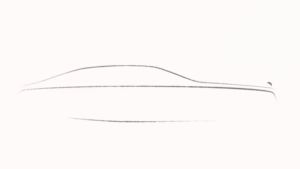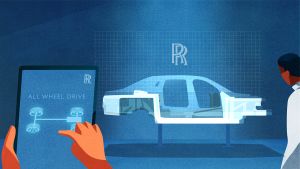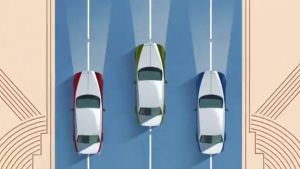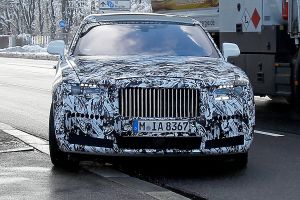A
Auto Express
Guest
The new Rolls-Royce Ghost has been teased for the fourth and final time ahead of the car’s scheduled launch in autumn this year, and the firm’s latest official video explores some of the challenges faced by engineers when trying to make the Ghost’s interior as quiet as possible.
We’ve already been told that the second-generation Ghost will be based on Rolls-Royce’s latest aluminium space-frame underpinnings, which means it can take advantage of the company’s existing four-wheel drive and four-wheel steering systems. The platform will also support the firm’s “Magic Carpet” suspension, which promises greatly improved ride quality.
However, the company says its main reason for using aluminium is for its resonant properties – the metal is less susceptible to vibrations than steel, which means less noise makes its way into the cabin. Rolls-Royce has also formed most of the surfaces on the new Ghost’s body-in-white into curved structures rather than flat panels, which aids in further suppressing sound.
The new Ghost will feature a twin-skinned bulkhead, double glazing and more than 100kg of sound-deadening in its roof, boot and floor. Even the inside of the air conditioning vents have been smoothed out, as the noise created by the turbulent air was deemed “unacceptable” by the firm’s engineers.
However, the firm has artificially engineered some intrusive noise back into the interior – but only at a specific frequency, which passengers supposedly experience as a background “whisper.”
Rolls-Royce has also designed a new, pot-hole smothering suspension setup. It’s called the Planar system and it comprises three elements – the first of which is a new upper wishbone damper unit, which smoothes out the travel of the front suspension arms to provide a more stable ride.
The second aspect is the “Flagbearer” system, which uses an array of cameras and sensors to read the road ahead and prepare the suspension system for any changes in the surface. Finally, Rolls-Royce has developed a new satellite aided transmission, which uses GPS data to pre-emptively select the correct gear for upcoming corners.
Rolls-Royce’s previous teaser videos considered the firm’s newly minted, younger customer base and their desire for more subdued styling. The company has incorporated this feedback Mk2 Ghost’s design, building the car’s aesthetic around a more minimalist approach.
So, for its second generation, the Ghost will take on a far less fussy design. The car’s panel lines will be smoothed over, the body mouldings along the car’s flanks will be kept to a minimum and every piece of unnecessary styling is being shunned – so the old car’s chrome badges and flashy brightwork will likely be ditched for more understated alternatives.
New Rolls-Royce Ghost: design and platform
The design approach outlined in Rolls-Royce’s teaser campaign seems to be reflected by our most recent spy shots. Previously spied mules feature a pair of less complicated LED headlamps, a smoother front bumper and fewer creases in the bonnet and wings – although the car’s trademark suicide rear doors remain.
Inside, the new Ghost will adopt Rolls-Royce’s latest infotainment screen and digital gauge cluster, as found in the Phantom and Cullinan. So, the car’s gauges will be displayed on a 12.3-inch TFT monitor, while the central infotainment screen will disappear into the dash at the touch of a button. The Ghost’s entire interior design will be overhauled, too.

Rolls-Royce Ghost spies - rear 3/4

image

image

Rolls-Royce Ghost spies - front

image

image

image

Rolls-Royce Ghost spies - front 3/4

Rolls-Royce Ghost spies - front 3/4

image

image

image

Rolls-Royce Ghost spies - rear

image

Rolls-Royce Ghost spies - front

Rolls-Royce Ghost spies - side

image

image

image

image
We’ve also spied the more opulent long-wheelbase model, undergoing cold-weather testing in the arctic circle. The extra space between the axles is purely for the benefit of rear-seat occupants and is unlikely to drastically alter the experience from the driver’s point of view.
Like its bigger brother, the eighth-generation Phantom, the new Ghost will be based on Rolls-Royce’s all-new “Architecture of Luxury” platform. The fully-scalable, all-aluminium space-frame chassis underpin all of the company’s next-generation models, taking the place of the previous Ghost’s BMW 7 Series-based underpinnings.
Rolls-Royce has also confirmed that the next-generation Ghost will be powered by the latest iteration of the company’s 6.75-litre V12 engine, which has now sprouted a pair of turbos. It’s the same unit found in the Phantom and the Cullinan – and, like both of those cars, it’ll be mated to an eight-speed automatic gearbox and offer power figures in excess of 560bhp.
Now read our review of the previous-generation Rolls-Royce Ghost here...
Continue reading...
We’ve already been told that the second-generation Ghost will be based on Rolls-Royce’s latest aluminium space-frame underpinnings, which means it can take advantage of the company’s existing four-wheel drive and four-wheel steering systems. The platform will also support the firm’s “Magic Carpet” suspension, which promises greatly improved ride quality.
- SEE MORE Best luxury cars 2020
However, the company says its main reason for using aluminium is for its resonant properties – the metal is less susceptible to vibrations than steel, which means less noise makes its way into the cabin. Rolls-Royce has also formed most of the surfaces on the new Ghost’s body-in-white into curved structures rather than flat panels, which aids in further suppressing sound.
The new Ghost will feature a twin-skinned bulkhead, double glazing and more than 100kg of sound-deadening in its roof, boot and floor. Even the inside of the air conditioning vents have been smoothed out, as the noise created by the turbulent air was deemed “unacceptable” by the firm’s engineers.
However, the firm has artificially engineered some intrusive noise back into the interior – but only at a specific frequency, which passengers supposedly experience as a background “whisper.”
Rolls-Royce has also designed a new, pot-hole smothering suspension setup. It’s called the Planar system and it comprises three elements – the first of which is a new upper wishbone damper unit, which smoothes out the travel of the front suspension arms to provide a more stable ride.
The second aspect is the “Flagbearer” system, which uses an array of cameras and sensors to read the road ahead and prepare the suspension system for any changes in the surface. Finally, Rolls-Royce has developed a new satellite aided transmission, which uses GPS data to pre-emptively select the correct gear for upcoming corners.
Rolls-Royce’s previous teaser videos considered the firm’s newly minted, younger customer base and their desire for more subdued styling. The company has incorporated this feedback Mk2 Ghost’s design, building the car’s aesthetic around a more minimalist approach.
So, for its second generation, the Ghost will take on a far less fussy design. The car’s panel lines will be smoothed over, the body mouldings along the car’s flanks will be kept to a minimum and every piece of unnecessary styling is being shunned – so the old car’s chrome badges and flashy brightwork will likely be ditched for more understated alternatives.
New Rolls-Royce Ghost: design and platform
The design approach outlined in Rolls-Royce’s teaser campaign seems to be reflected by our most recent spy shots. Previously spied mules feature a pair of less complicated LED headlamps, a smoother front bumper and fewer creases in the bonnet and wings – although the car’s trademark suicide rear doors remain.
Inside, the new Ghost will adopt Rolls-Royce’s latest infotainment screen and digital gauge cluster, as found in the Phantom and Cullinan. So, the car’s gauges will be displayed on a 12.3-inch TFT monitor, while the central infotainment screen will disappear into the dash at the touch of a button. The Ghost’s entire interior design will be overhauled, too.

Rolls-Royce Ghost spies - rear 3/4

image

image

Rolls-Royce Ghost spies - front

image

image

image

Rolls-Royce Ghost spies - front 3/4

Rolls-Royce Ghost spies - front 3/4

image

image

image

Rolls-Royce Ghost spies - rear

image

Rolls-Royce Ghost spies - front

Rolls-Royce Ghost spies - side

image

image

image

image
We’ve also spied the more opulent long-wheelbase model, undergoing cold-weather testing in the arctic circle. The extra space between the axles is purely for the benefit of rear-seat occupants and is unlikely to drastically alter the experience from the driver’s point of view.
Like its bigger brother, the eighth-generation Phantom, the new Ghost will be based on Rolls-Royce’s all-new “Architecture of Luxury” platform. The fully-scalable, all-aluminium space-frame chassis underpin all of the company’s next-generation models, taking the place of the previous Ghost’s BMW 7 Series-based underpinnings.
Rolls-Royce has also confirmed that the next-generation Ghost will be powered by the latest iteration of the company’s 6.75-litre V12 engine, which has now sprouted a pair of turbos. It’s the same unit found in the Phantom and the Cullinan – and, like both of those cars, it’ll be mated to an eight-speed automatic gearbox and offer power figures in excess of 560bhp.
Now read our review of the previous-generation Rolls-Royce Ghost here...
Continue reading...
